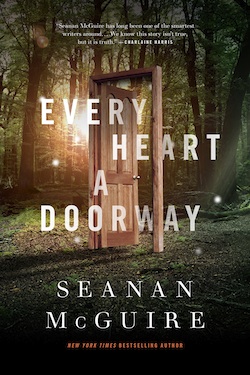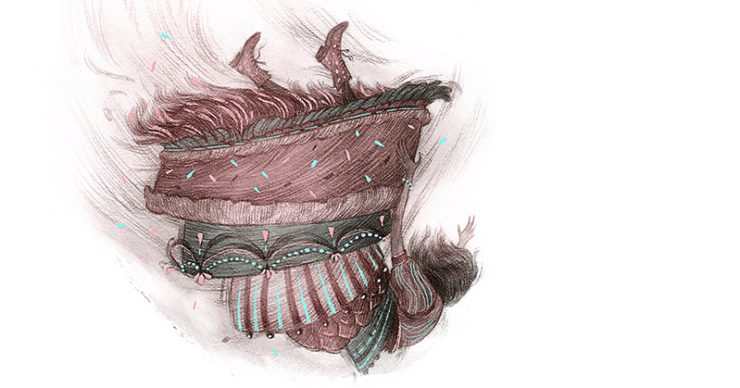Let’s talk about doors for a moment, you and I.
Let’s talk about the power of something closed, whether or not it’s been forbidden; the mystery of the trapdoor that leads up into the attic, the powerful draw of the locked hatch that leads down into the cellar, the irresistible temptation of someone else’s fridge or medicine cabinet. We want to know what’s on the other side—and I don’t mean we want to be told. We want to see. We want to look with our own eyes, and know that no one can take that looking away from us. People are curious. It’s one of our defining characteristics. We want to know.
Children’s stories are filled with doors just begging to be opened, and some of the best and most beloved of those stories are about opening those doors. About traveling over the rainbow to a magical, Technicolor land where they, as the chosen ones, can finally make a difference. About discovering a secret, magical destiny that makes everything worthwhile.
We all know the way these stories go—enough so that I’m willing to bet everyone reading this thought of at least one story during the preceding paragraph, and that those stories didn’t always match up with the ones I was thinking of. (My story about the rainbow, for example, was the original My Little Pony, where a farm girl named Megan was chosen for her smarts, her spunk, and her opposable thumbs to defend Ponyland. She helped the Ponies kick the Devil’s ass.) The chosen one (or chosen few) travels through the door to the magical land, fights whatever evil is lurking there, and then returns to their home before their parents have the chance to worry.
Wait…what? I don’t know about the rest of you, but if I’d been chosen to travel to a land of talking horses and magical adventures when I was nine, I would have been homesick for like, ten minutes before I got down to the business of having magical adventures with talking horses. I would probably have realized eventually that deserting my family to save the world was an asshole thing to do, but by that point, I would have been in my late teens, with no idea what humans were actually like, and would probably have decided to stay exactly where I was rather than complicate everyone’s life by going back.
(It’s probably telling that my favorite portal fantasy of recent years was Catherynne Valente’s excellent The Girl Who Circumnavigated Fairyland in a Ship of Her Own Making, wherein September takes one look at her personal magical land and goes “Yes. This one. I’ll take this one.”)
Portal fantasies are a uniquely immersive form of escapism. Here is someone just like you—yes, you, no matter who you are, they’re just like you—who opens the right door or falls down the right rabbit hole or solves the right riddle, and is rewarded with a world that is so perfect for them that it might as well have been designed as a learning experience by some all-seeing author. Children get to be heroes. People with nothing get to have everything. And at the end, the chairs are put on the tables and the lights and turned out, and everyone goes home saying “Good job, see you next time.”
But what about those kids?
What about the chosen ones who find out that they’re less lifelong companions, and more Christmas puppies, abandoned as soon as they aren’t little and cute anymore? What about the chosen ones who can’t get over what they’ve seen, what they’ve done, what they’ve been required to do? For me, the unrealistic thing about Narnia wasn’t that they found it at the back of a wardrobe; it was that only Susan eventually turned her back on something that had rejected her so utterly and unforgivably.
But. But.
If every portal fantasy starts with our world—not just the Dorothys and the Pevensies and the Wendy Darlings, but the Megans and the Sarah Williamses and the kids from Dungeons and Dragons: The Series—then how many damaged, traumatized former “chosen ones” would we have to deal with? There’s an XKCD strip that perfectly sums up the problem: “Well, I guess I spend the rest of my life pretending that didn’t happen, or knowing that everyone I love suspects I’m crazy.” How do they find a way to cope?
 I wanted to know. Once I’d really started thinking about it, I needed to know. I’ve done my share of therapy, and part of the healing process is being around people who’ve had similar experiences, which gives them the empathy to understand what you’re going through. So shoving a bunch of these people together and watching what happened was only natural. Only Daryl Gregory went and wrote We Are All Completely Fine, which is (a) majestic, and (b) about a specialized form of group therapy, which meant that was out. Dammit.
I wanted to know. Once I’d really started thinking about it, I needed to know. I’ve done my share of therapy, and part of the healing process is being around people who’ve had similar experiences, which gives them the empathy to understand what you’re going through. So shoving a bunch of these people together and watching what happened was only natural. Only Daryl Gregory went and wrote We Are All Completely Fine, which is (a) majestic, and (b) about a specialized form of group therapy, which meant that was out. Dammit.
Where else do you find kids with similar experiences? Camps…and schools. Especially boarding schools.
Enter Eleanor West’s School for Wayward Children (and its sister school, which will be detailed more in future volumes). Eleanor was a chosen one too; she knows how much it hurts when the doors swing closed, when the clouds come back and the rainbow disappears. She knows how to help the kids whose magical worlds have left them, possibly forever, and she’s willing to devote her life to doing whatever she can to lessen the sting, at least until she finds her own way back. Because that’s what her school is all about: finding a way to live with it, and finding the way back home.
Every Heart a Doorway is about doors. Doors we open; doors we close; doors we see in a dream and can never seem to find again. It’s about the things we share and the things we can’t share, and how they connect to each other. But mostly, it’s about me when I was six years old, watching in amazement as a blue box appeared in front of a girl who was just like me—just like me—and offered her the universe. It’s about a blonde girl being carried over the rainbow by a pink Pegasus, and a teenager offering her baby brother to the Goblin King. It’s about the friends of my childhood, and finding a way to check in on them, and the stories that they represent, now that we’re both a little bit older, and a little bit wiser, and a little bit more lost.
Doors are important.
What we find on the other side matters even more.
New York Times bestselling author Seanan McGuire is the author of the October Daye urban fantasy series, the InCryptid series, and several other works, both standalone and in trilogies. She lives in a creaky old farmhouse in Northern California, and was the winner of the 2010 John W. Campbell Award for Best New Writer. In 2013 she became the first person ever to appear fives times on the same Hugo ballot. Her novella Every Heart a Doorway comes out April 5th from Tor.com Publishing.










